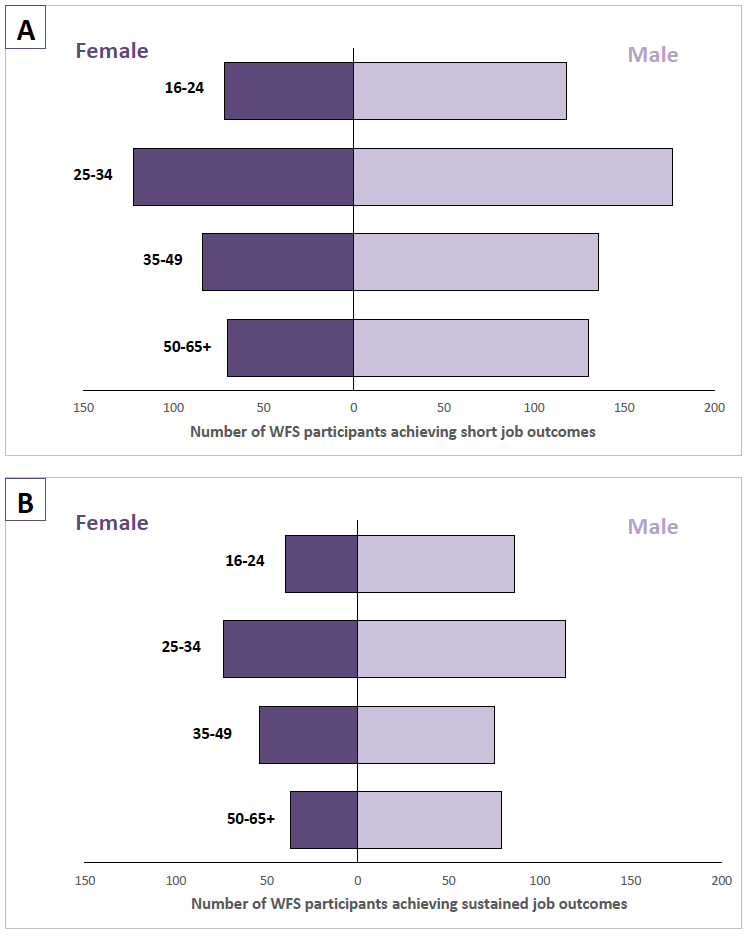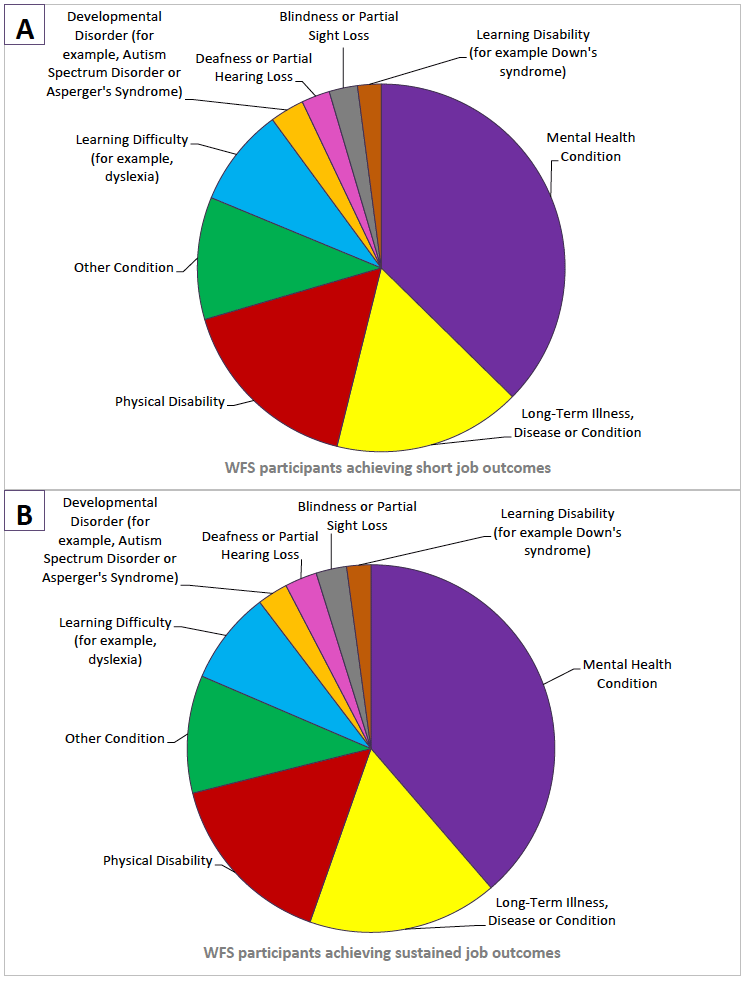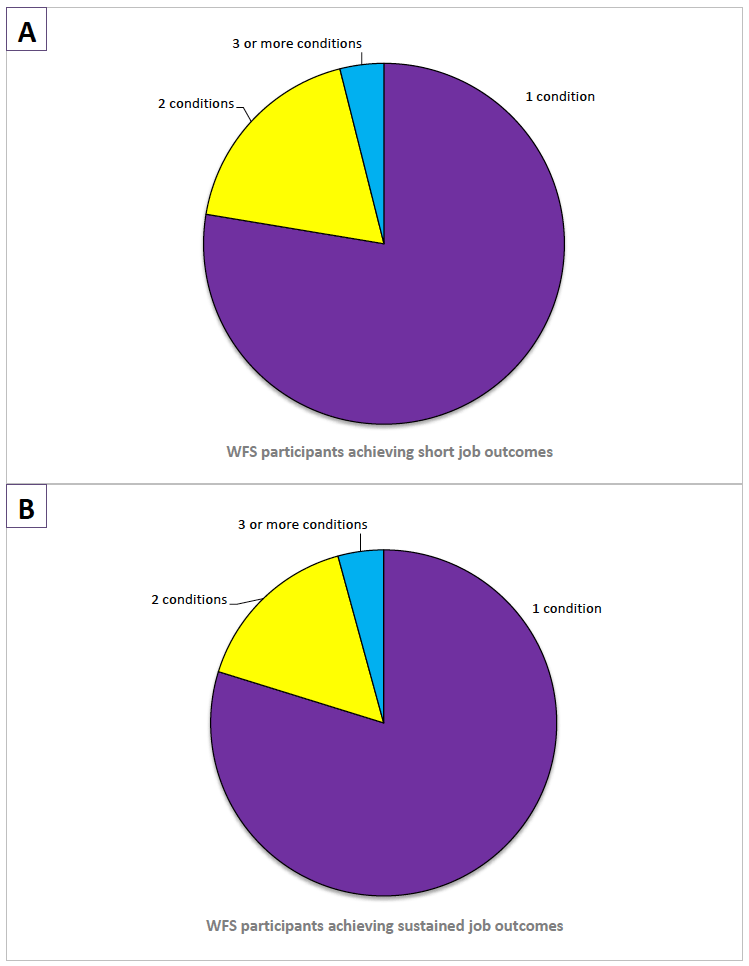Work First Scotland and Work Able Scotland: statistical summary August 2018
The fourth edition of devolved Scottish employability services experimental statistics.
This document is part of a collection
Work First Scotland Participants
Information on Work First Scotland participants is presented for people who started on the service, and those who had achieved short and sustained job outcomes at 29 June 2018. This information is derived directly from data collected by WFS service providers. The total numbers of WFS participants achieving short (917) and sustained (565) job outcomes in this section differ slightly from those in the flow diagram on page 7 (907 for short, and 563 for sustained job outcomes) because they are derived from separate administrative systems. Please see the Technical Annex for details.
The statistics on type of long-term health condition are derived from information collected by service providers for service delivery purposes, whilst those on age, gender and ethnic group are derived from information collected for equalities monitoring purposes. All information is self-reported.
Figure 2: Work First Scotland participants achieving short (Figure 2A) and sustained (Figure 2B) job outcomes at 29 June 2018, by age and gender

Table 2: Work First Scotland participants achieving short (Table 2A) and sustained (Table 2B) job outcomes at 29 June 2018, by age and gender
| Age Group | Female | Male | Unknown | % by age group | Total |
|---|---|---|---|---|---|
| 16-24 | 70 | 130 | 2 | 22.0 | 202 |
| 25-34 | 84 | 136 | 0 | 24.0 | 220 |
| 35-49 | 122 | 177 | 2 | 32.8 | 301 |
| 50-65+ | 72 | 118 | 2 | 20.9 | 192 |
| Unknown | 1 | 1 | 0 | 0.2 | 2 |
| % by gender | 38.1 | 61.3 | 0.7 | 100 [8] | |
| Total | 349 | 562 | 6 | 917 |
| Age Group | Female | Male | Unknown | % by age group | Total |
|---|---|---|---|---|---|
| 16-24 | 37 | 79 | 1 | 20.7 | 117 |
| 25-34 | 54 | 75 | 0 | 22.8 | 129 |
| 35-49 | 74 | 114 | 2 | 33.6 | 190 |
| 50-65+ | 40 | 86 | 1 | 22.5 | 127 |
| Unknown | 1 | 1 | 0 | 0.4 | 2 |
| % by gender | 36.5 | 62.8 | 0.7 | 100 | |
| Total | 206 | 355 | 4 | 565 |
Table 3: Work First Scotland participants, by age and gender
| Age Group | Female | Male | Unknown | % by age group | Total |
|---|---|---|---|---|---|
| 16-24 | 281 | 521 | 5 | 18.2 | 807 |
| 25-34 | 339 | 632 | 0 | 21.9 | 971 |
| 35-49 | 513 | 871 | 4 | 31.3 | 1,388 |
| 50-65+ | 460 | 788 | 2 | 28.2 | 1,250 |
| Unknown | 8 | 8 | 0 | 0.4 | 16 |
| % by gender | 36.1 | 63.6 | 0.2 | 100 | |
| Total | 1,601 | 2,820 | 11 | 4,432 |
Figures 2A and 2B, alongside Tables 2A and 2B, show that whilst the proportion of participants in each age group who achieved both short and sustained job outcomes is broadly similar to those who joined the service, higher proportions of participants aged under 35 achieved short (46%), and sustained (44%) job outcomes, compared to those in the same age group who joined the service (40%, Table 3). Conversely, lower proportions of those in the older age groups (35 or over) achieved short (54%) and sustained (56%) job outcomes compared to those who joined the service (60%). Females accounted for over a third of all those achieving short or sustained job outcomes, and those joining the service.
Figure 3: Work First Scotland participants achieving short (Figure 3A) and sustained (Figure 3B) job outcomes at 29 June 2018, by type of long-term health condition

Table 4: Work First Scotland participants achieving short and sustained job outcomes at 29 June 2018, by type of long-term health condition
| Short job outcomes | Sustained job outcomes | |||
|---|---|---|---|---|
| Type of long-term health condition | Number of all types of condition reported | % of all types of condition reported | Number of all types of condition reported | % of all types of condition reported |
| Mental health condition | 434 | 37.3 | 273 | 38.7 |
| Physical disability | 193 | 16.6 | 111 | 15.7 |
| Long-term illness, disease or condition | 192 | 16.5 | 118 | 16.7 |
| Other Condition | 125 | 10.8 | 73 | 10.3 |
| Learning difficulty (for example, dyslexia) | 101 | 8.7 | 58 | 8.2 |
| Developmental disorder (for example, Autism Spectrum Disorder or Asperger's Syndrome) | 35 | 3.0 | 19 | 2.7 |
| Deafness or partial hearing loss | 29 | 2.5 | 20 | 2.8 |
| Blindness or partial sight loss | 29 | 2.5 | 19 | 2.7 |
| Learning disability (for example, Down’s Syndrome) | 24 | 2.1 | 15 | 2.1 |
| Total | 1,162 [9] | 100 | 706 | 100 [8] |
Table 5: Work First Scotland participants, by type of long-term health condition
| Type of long-term health condition | Number of types of long-term health condition | % of types of long-term health condition |
|---|---|---|
| Mental health condition | 1,948 | 32.8 |
| Long-term illness, disease or condition | 1,036 | 17.4 |
| Physical disability | 1,031 | 17.3 |
| Other condition | 642 | 10.8 |
| Learning difficulty (for example, dyslexia) | 570 | 9.6 |
| Deafness or partial hearing loss | 207 | 3.5 |
| Developmental disorder (for example, Autism Spectrum Disorder or Asperger's Syndrome) | 176 | 3.0 |
| Blindness or partial sight loss | 171 | 2.9 |
| Learning disability (for example, Down’s Syndrome) | 164 | 2.8 |
| Total | 5,945 [9] | 100 [8] |
Figures 3A and 3B, alongside Tables 4 and 5, show that over a third of all types of condition reported by participants achieving short (37%) and sustained (39%) job outcomes were mental health conditions, and this is higher than the proportion reported by those joining the service (33%). Overall, the distribution of types of long-term health conditions was broadly similar for those achieving short and sustained outcomes, and for those joining the service. Long-term illnesses, diseases or conditions accounted for just under 17% of all types of conditions reported by participants who achieved both short or sustained job outcomes, with physical disabilities accounting for similar proportions. A learning difficulty accounted for 9% and 8% of all types of conditions reported for those achieving short and sustained outcomes, respectively, and 10% for those joining WFS.
Figure 4: Work First Scotland participants achieving short (Figure 4A) and sustained (Figure 4B) job outcomes at 29 June 2018, by number of types of long-term health condition

Table 6: Work First Scotland participants achieving short and sustained job outcomes at 29 June 2018, by number of types of long-term health condition
| Short job outcomes | Sustained job outcomes | |||
|---|---|---|---|---|
| Number of types of long-term health condition | Number of WFS participants | % of WFS participants | Number of WFS participants | % of WFS participants |
| 1 | 711 | 77.5 | 450 | 79.6 |
| 2 | 169 | 18.4 | 90 | 15.9 |
| 3 or more | 36 | 3.9 | 24 | 4.2 |
| Unknown | 1 | 0.1 | 1 | 0.2 |
| Total | 917 | 100 [8] | 565 | 100 [8] |
Table 7: Work First Scotland participants, by number of types of long-term health condition
| Number of types of long-term health condition | Number of WFS participants | % of WFS participants |
|---|---|---|
| 1 | 3,215 | 72.5 |
| 2 | 945 | 21.3 |
| 3 or more | 266 | 6.0 |
| Unknown | 6 | 0.1 |
| Total | 4,432 | 100 [8] |
Figures 4A and 4B, together with Table 6, show that more than three quarters of participants achieving short (78%) and sustained (80%) job outcomes reported having one long-term health condition, and this is higher than the proportion of individuals joining the service with one condition (73%, Table 7). Whilst 27% of those joining the service reported having 2 or more conditions, lower proportions of those with 2 or more conditions achieved short (22%) and sustained (20%) job outcomes.
Table 8: Work First Scotland participants achieving short and sustained job outcomes at 29 June 2018, by ethnic group
| Short job outcomes | Sustained job outcomes | |||
|---|---|---|---|---|
| Ethnic group | Number of WFS participants | % of WFS participants | Number of WFS participants | % of WFS participants |
| White | 848 | 92.5 | 517 | 91.5 |
| Minority ethnic [10] | 34 | 3.7 | 23 | 4.1 |
| Unknown | 35 | 3.8 | 25 | 4.4 |
| Total | 917 | 100 | 565 | 100 |
Table 9: Work First Scotland participants, by ethnic group
| Ethnic group | Number of WFS participants | % of WFS participants |
|---|---|---|
| White | 4,105 | 92.6 |
| Minority ethnic [10] | 166 | 3.7 |
| Unknown | 161 | 3.6 |
| Total | 4,432 | 100 [8] |
Tables 8 and 9 show that around 4% of participants achieving short and sustained job outcomes, as well as those joining the service, reported being from minority ethnic groups.
Contact
There is a problem
Thanks for your feedback